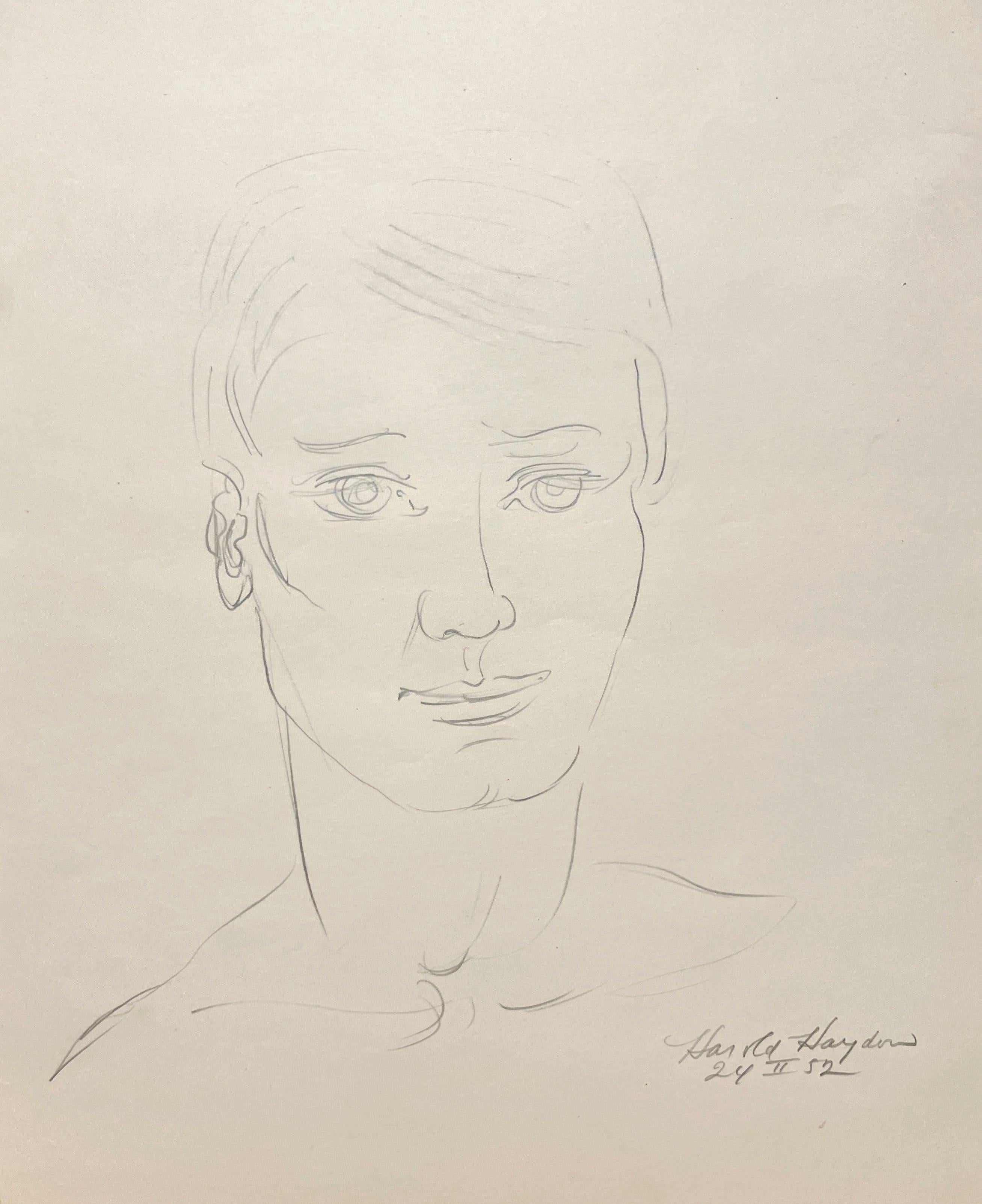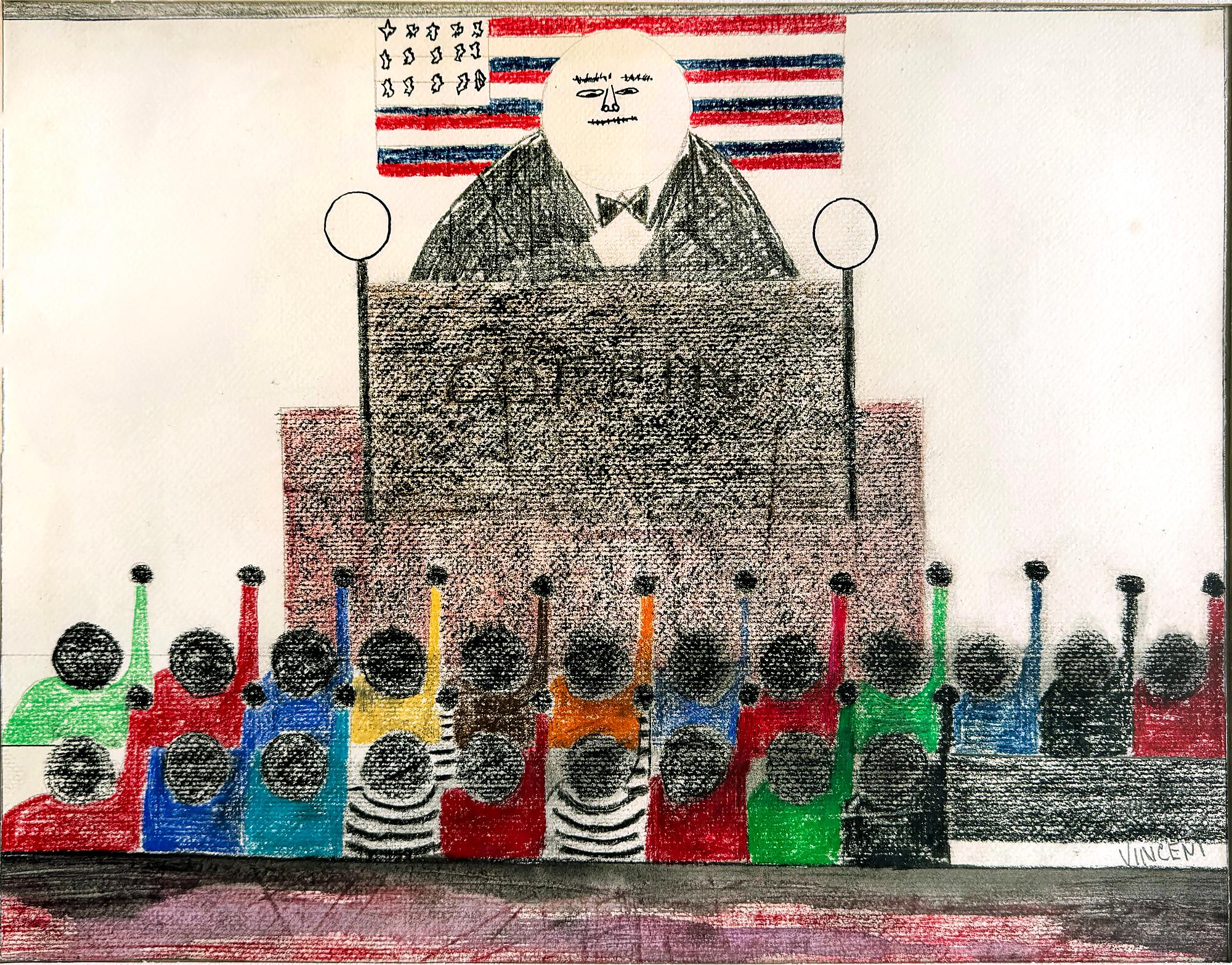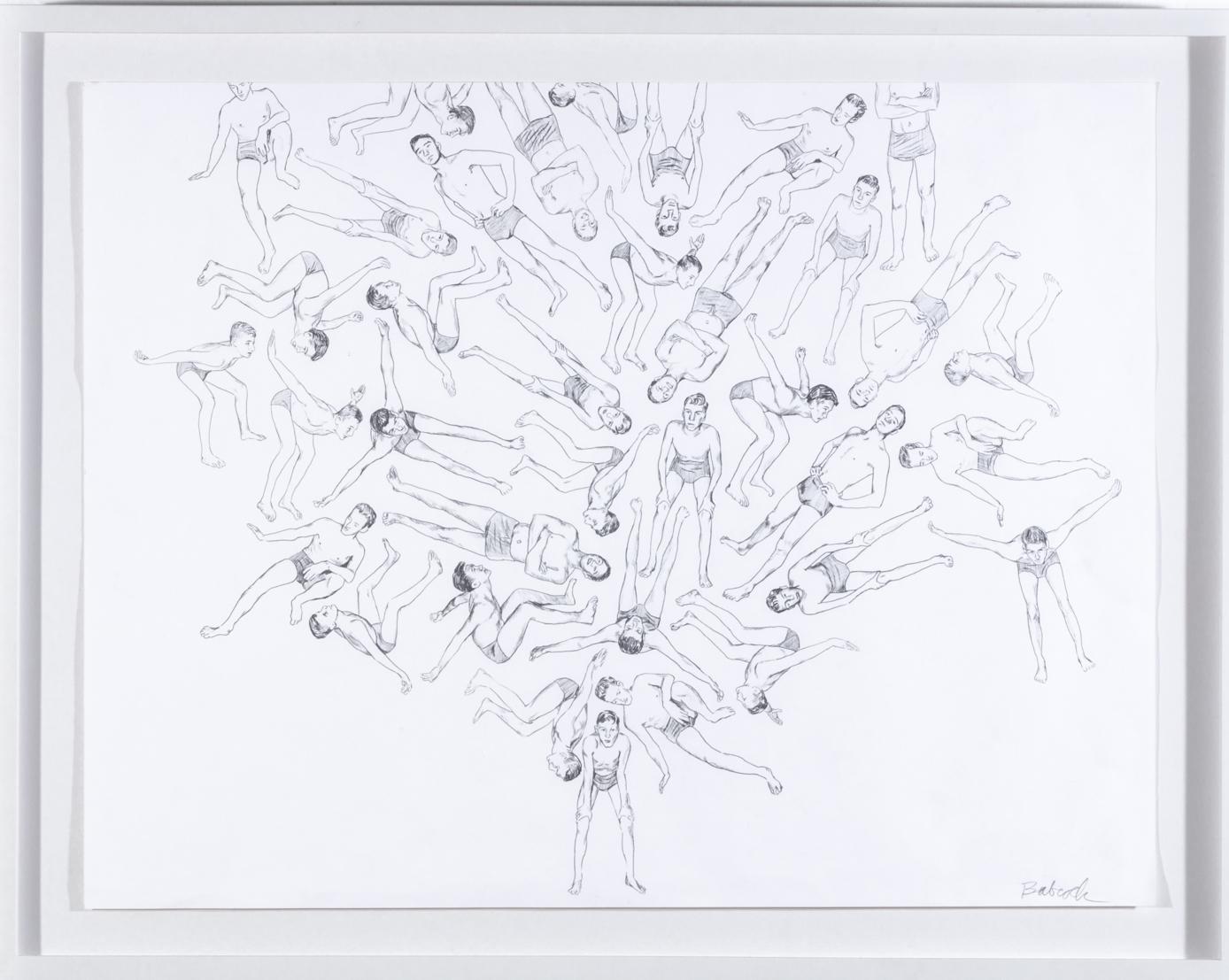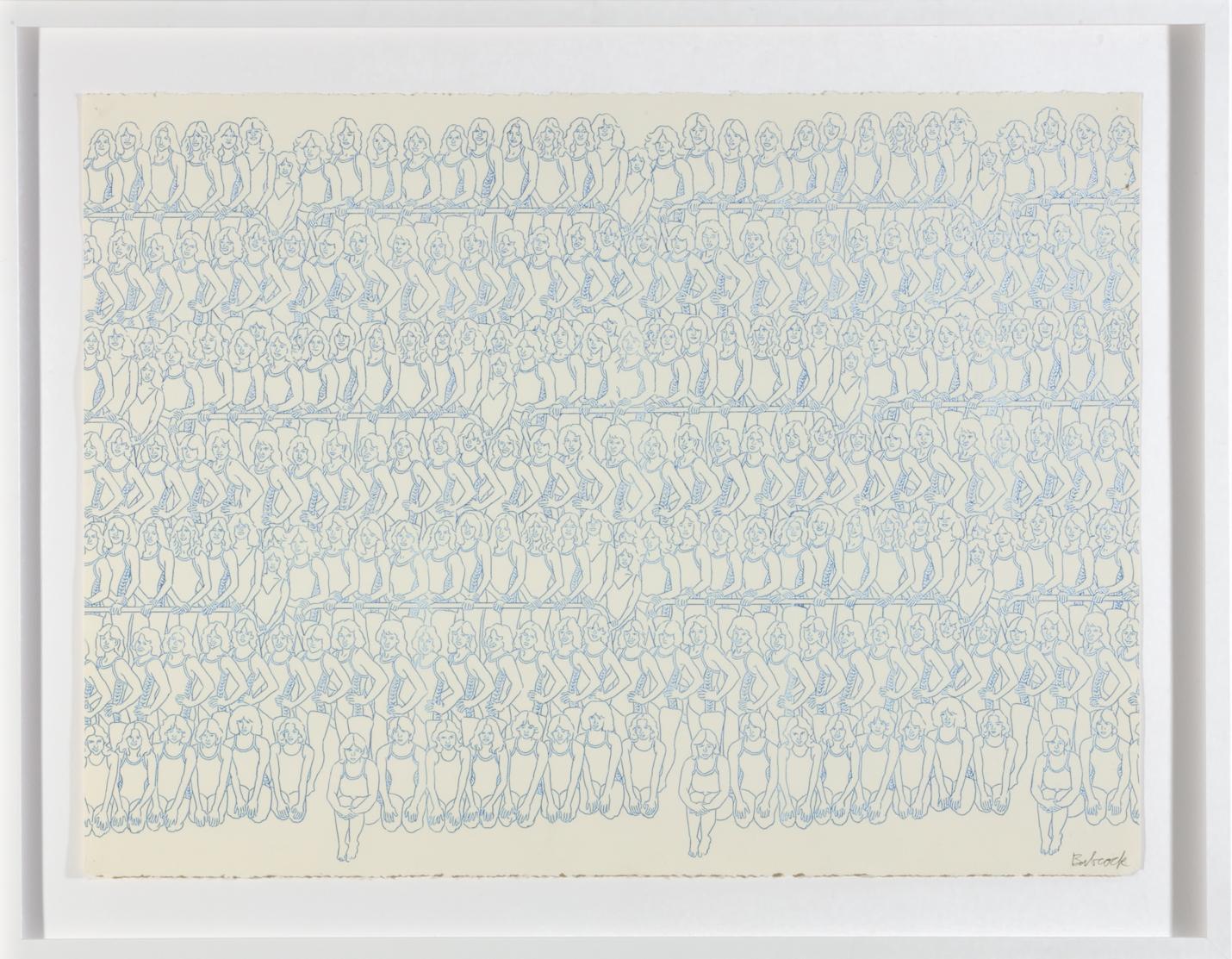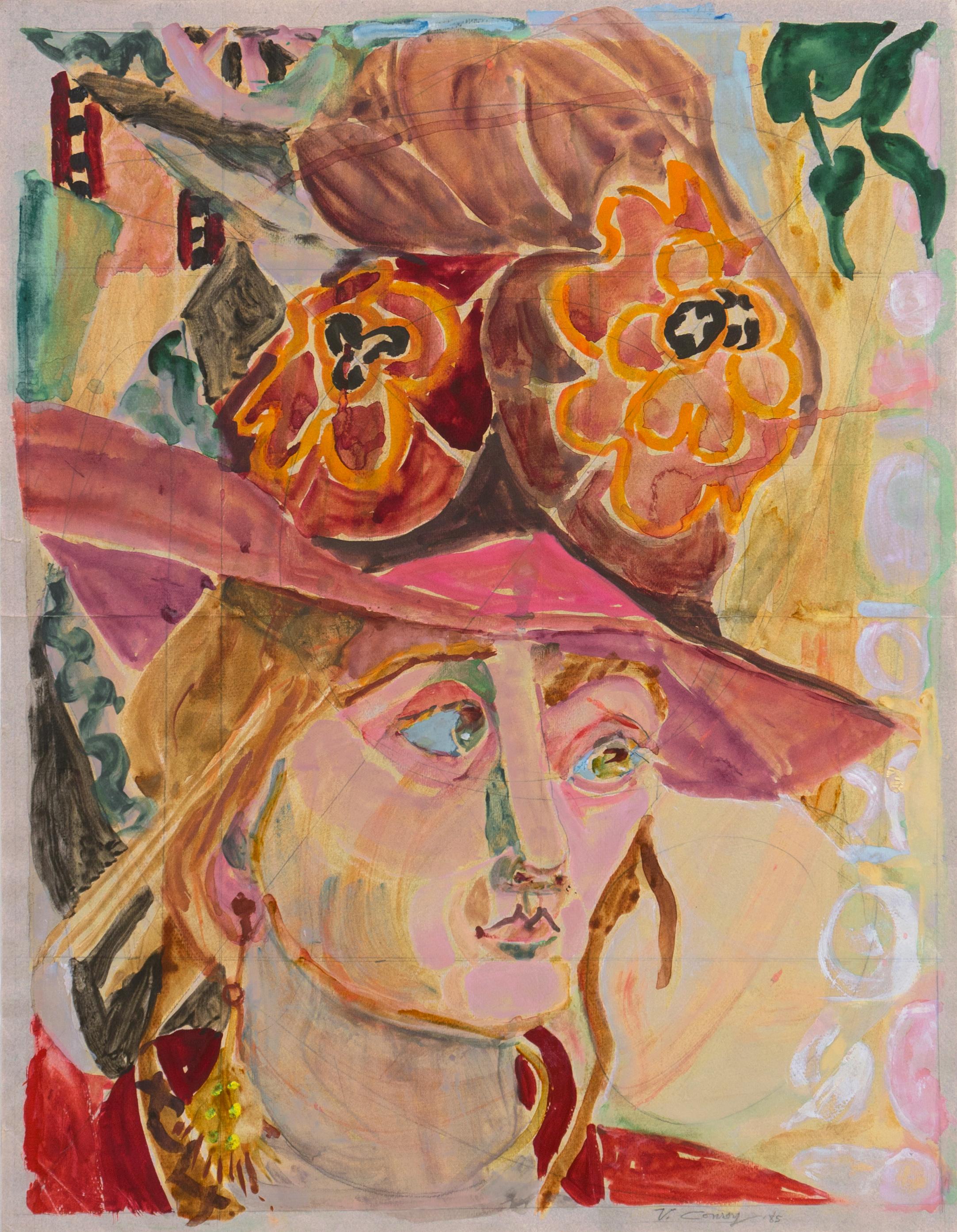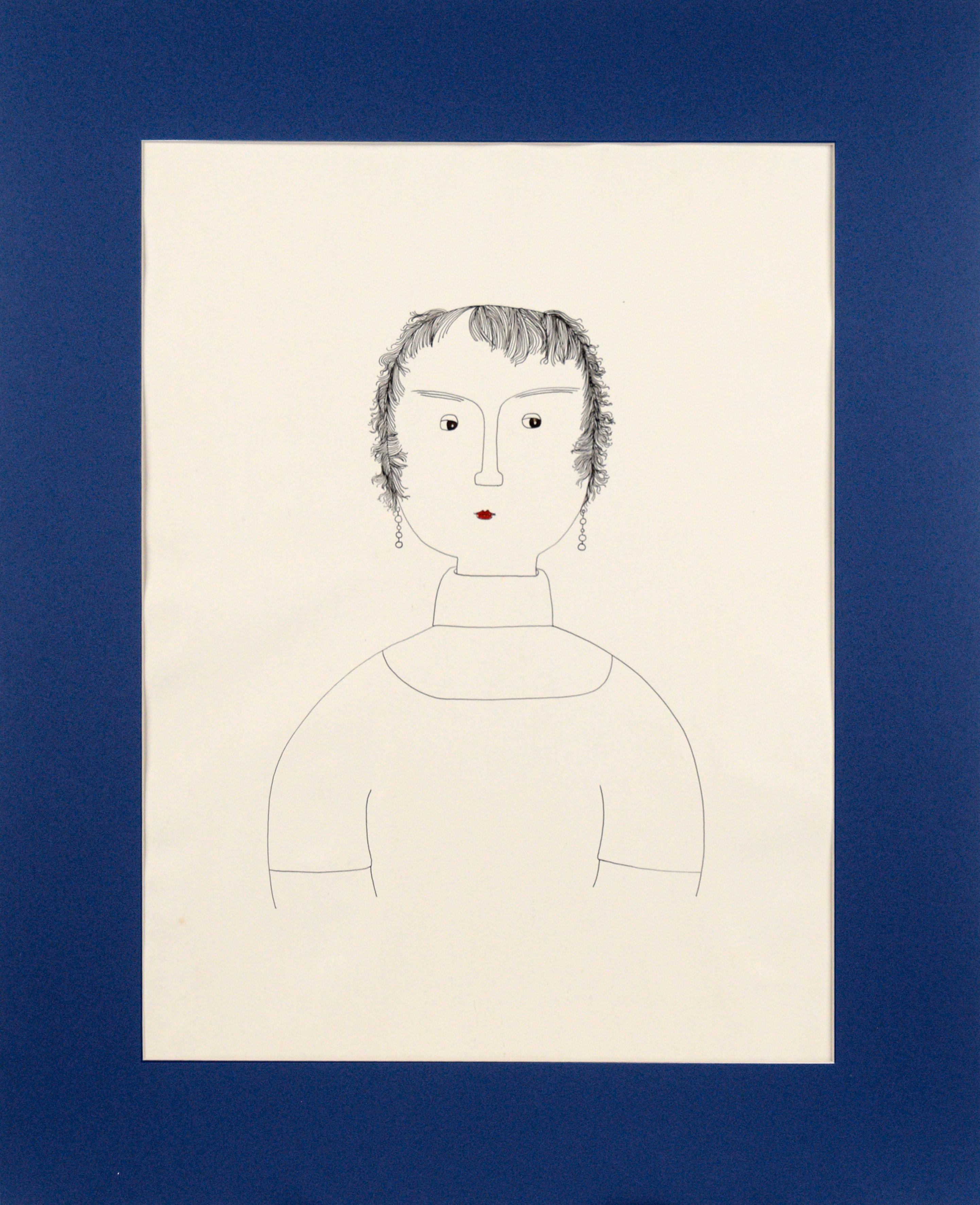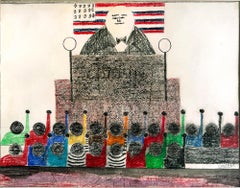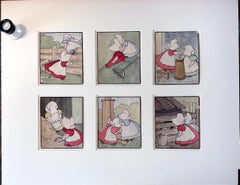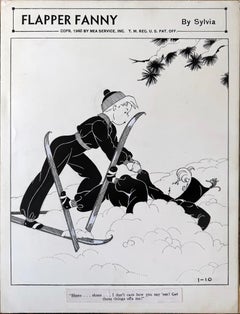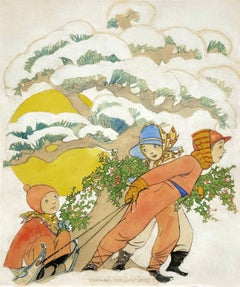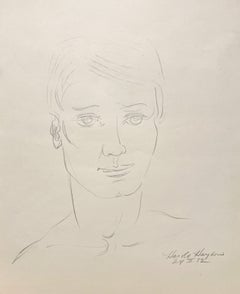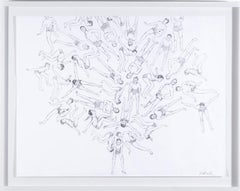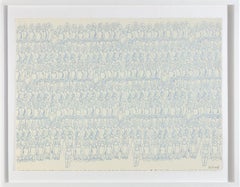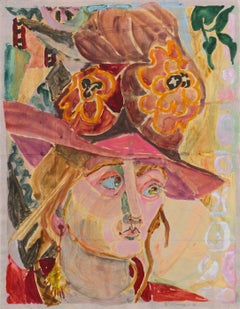Items Similar to Surprised Woman with Cactus 1920s Female Illustrator
Want more images or videos?
Request additional images or videos from the seller
1 of 7
Susan FlintSurprised Woman with Cactus 1920s Female Illustrator1930s
1930s
About the Item
The postman's delivery of a limp cactus creates a big emotional response the female recipient. Most likely an interior illustration for a newsstand magazine. Signed lower right Susan. unframed
Noted listed artist from the first half of the twentieth century, largely self-taught. Flint created some of her artwork and finest prints during the Depression era. She exhibited her original lithographs with the Salons of America in 1934 and 1936. She is noted for her imaginative work with animals and everyday scenes. During the poorest of times, Susan Willard Flint depicted the delights of domestic life and activities, such as the circus. Her work is in major collections and is deemed as superior "folk art" of this era.
- Creator:Susan Flint (1902 - 1984, American)
- Creation Year:1930s
- Dimensions:Height: 7.75 in (19.69 cm)Width: 7.25 in (18.42 cm)
- Medium:
- Movement & Style:
- Period:
- Condition:condition is good. There are some wrinkles but not visible with frontal light when viewing the image. On verso, with raking light wrinkles show.
- Gallery Location:Miami, FL
- Reference Number:1stDibs: LU385311785482

About the Seller
4.9
Vetted Professional Seller
Every seller passes strict standards for authenticity and reliability
Established in 2005
1stDibs seller since 2016
112 sales on 1stDibs
Typical response time: 1 hour
- ShippingRetrieving quote...Shipping from: Miami, FL
- Return Policy
Authenticity Guarantee
In the unlikely event there’s an issue with an item’s authenticity, contact us within 1 year for a full refund. DetailsMoney-Back Guarantee
If your item is not as described, is damaged in transit, or does not arrive, contact us within 7 days for a full refund. Details24-Hour Cancellation
You have a 24-hour grace period in which to reconsider your purchase, with no questions asked.Vetted Professional Sellers
Our world-class sellers must adhere to strict standards for service and quality, maintaining the integrity of our listings.Price-Match Guarantee
If you find that a seller listed the same item for a lower price elsewhere, we’ll match it.Trusted Global Delivery
Our best-in-class carrier network provides specialized shipping options worldwide, including custom delivery.More From This Seller
View AllBlack Panther Trials - Civil Rights Movement Police Violence African American
Located in Miami, FL
The Black Panther Trials - In this historically significant work, African American Artist Vicent D. Smith functions as an Art Journalist/ Court Reporter as much as a
Artist. Here, he depicts, in complete unity, 21 Black Panther Protestors raising their fist of defiance at the White Judge. Smith's composition is about utter simplicity, where the Black Panther Protestors are symmetrically lined up in a confrontation with a Judge whose size is exaggerated in scale. Set against a stylized American Flag, the supercilious Judge gazes down as the protesters as their fists thrust up. Signed Vincent lower right. Titled Panter 21. Original metal frame. Tape on upper left edge of frame. 255 . Panther 21. Framed under plexi.
_____________________________
From Wikipedia
In 1969-1971 there was a series of criminal prosecutions in New Haven, Connecticut, against various members and associates of the Black Panther Party.[1] The charges ranged from criminal conspiracy to first-degree murder. All charges stemmed from the murder of 19-year-old Alex Rackley in the early hours of May 21, 1969. The trials became a rallying-point for the American Left, and marked a decline in public support, even among the black community, for the Black Panther Party
On May 17, 1969, members of the Black Panther Party kidnapped fellow Panther Alex Rackley, who had fallen under suspicion of informing for the FBI. He was held captive at the New Haven Panther headquarters on Orchard Street, where he was tortured and interrogated until he confessed. His interrogation was tape recorded by the Panthers.[2] During that time, national party chairman Bobby Seale visited New Haven and spoke on the campus of Yale University for the Yale Black Ensemble Theater Company.[3] The prosecution alleged, but Seale denied, that after his speech, Seale briefly stopped by the headquarters where Rackley was being held captive and ordered that Rackley be executed. Early in the morning of May 21, three Panthers – Warren Kimbro, Lonnie McLucas, and George Sams, one of the Panthers who had come East from California to investigate the police infiltration of the New York Panther chapter, drove Rackley to the nearby town of Middlefield, Connecticut. Kimbro shot Rackley once in the head and McLucas shot him once in the chest. They dumped his corpse in a swamp, where it was discovered the next day. New Haven police immediately arrested eight New Haven area Black Panthers. Sams and two other Panthers from California were captured later.
Sams and Kimbro confessed to the murder, and agreed to testify against McLucas in exchange for a reduction in sentence. Sams also implicated Seale in the killing, telling his interrogators that while visiting the Panther headquarters on the night of his speech, Seale had directly ordered him to murder Rackley. In all, nine defendants were indicted on charges related to the case. In the heated political rhetoric of the day, these defendants were referred to as the "New Haven Nine", a deliberate allusion to other cause-celebre defendants like the "Chicago Seven".
The first trial was that of Lonnie McLucas, the only person who physically took part in the killing who refused to plead guilty. In fact, McLucas had confessed to shooting Rackley, but nonetheless chose to go to trial.
Jury selection began in May 1970. The case and trial were already a national cause célèbre among critics of the Nixon administration, and especially among those hostile to the actions of the FBI. Under the Bureau's then-secret "Counter-Intelligence Program" (COINTELPRO), FBI director J. Edgar Hoover had ordered his agents to disrupt, discredit, or otherwise neutralize radical groups like the Panthers. Hostility between groups organizing political dissent and the Bureau was, by the time of the trials, at a fever pitch. Hostility from the left was also directed at the two Panthers cooperating with the prosecutors. Sams in particular was accused of being an informant, and lying to implicate Seale for personal benefit.
In the days leading up to a rally on May Day 1970, thousands of supporters of the Panthers arrived in New Haven individually and in organized groups. They were housed and fed by community organizations and by sympathetic Yale students in their dormitory rooms. The Yale college dining halls provided basic meals for everyone. Protesters met daily en masse on the New Haven Green across the street from the Courthouse (and one hundred yards from Yale's main gate). On May Day there was a rally on the Green, featuring speakers including Jean Genet, Abbie Hoffman, Jerry Rubin, and John Froines (an assistant professor of chemistry at the University of Oregon). Teach-ins and other events were also held in the colleges themselves.
Towards midnight on May 1, two bombs exploded in Yale's Ingalls Rink, where a concert was being held in conjunction with the protests.[4] Although the rink was damaged, no one was injured, and no culprit was identified.[4]
Yale chaplain William Sloane Coffin stated, "All of us conspired to bring on this tragedy by law enforcement agencies by their illegal acts against the Panthers, and the rest of us by our immoral silence in front of these acts," while Yale President Kingman Brewster Jr. issued the statement, "I personally want to say that I'm appalled and ashamed that things should have come to such a pass that I am skeptical of the ability of a Black revolutionary to receive a fair trial anywhere in the U.S." Brewster's generally sympathetic tone enraged many of the university's older, more conservative alumni, heightening tensions within the school community.
As tensions mounted, Yale officials sought to avoid deeper unrest and to deflect the real possibility of riots or violent student demonstrations. Sam Chauncey has been credited with winning tactical management on behalf of the administration to quell anxiety among law enforcement and New Haven's citizens, while Kurt Schmoke, a future Rhodes Scholar, mayor of Baltimore, MD and Dean of Howard University School of Law, has received kudos as undergraduate spokesman to the faculty during some of the protest's tensest moments. Ralph Dawson, a classmate of Schmoke's, figured prominently as moderator of the Black Student Alliance at Yale (BSAY).
In the end, compromises between the administration and the students - and, primarily, urgent calls for nonviolence from Bobby Seale and the Black Panthers themselves - quashed the possibility of violence. While Yale (and many other colleges) went "on strike" from May Day until the end of the term, like most schools it was not actually "shut down". Classes were made "voluntarily optional" for the time and students were graded "Pass/Fail" for the work done up to then.
Trial of McLucas
Black Panther trial sketch...
Category
1970s American Modern Figurative Drawings and Watercolors
Materials
Watercolor, Pen, Pencil, Paper
The Sunbonnet Babies - Modernist Female Artist
Located in Miami, FL
Bertha Corbett Melcher's The Sunbonnet Babies, with their flat, minimalist, semi-abstract, and symbolic style, are an early example of American Modernism/Surrealism by a lesser-known female artist/illustrator. The present work demonstrates a delicate balance between abstraction and representation and between the commonplace and the mysterious. Her signature use of a hat or sunbonnet to hide the identity of her subjects is a big conceptual and visual idea that has been overlooked in the fine art canon. The exact meaning of this is unknown, but 120 years after they were done, it resonates as somewhat surrealistic. Her work is a contradiction. She shows innocent children engaging in everyday activity but are depicted in vail of mystery. Why does she not show the faces of her subjects?
Watercolor on paper (each)
Six drawings in all on one board. 6-1/8 x 5 inches (15.6 x 12.7 cm) (each)
One signed; two initialed; three not signed.
Six drawing in all on one board. 6-1/8 x 5 inches (15.6 x 12.7 cm) (each)
One signed; two initialed; three not signed
The Sunbonnet Babies characters were created by illustration Bertha L. Corbett when she was challenged to create a faceless character who nonetheless was engaging and appealing. The characters were a wild hit and appeared in books, comics, and popular collectibles. They also became a popular motif in quilting. Few of Corbett's original drawings for the babies are known to survive, making this a rare offering.
From: Wikipedia
Sunbonnet Babies are characters created by commercial artist Bertha Corbett Melcher (1872–1950). Sunbonnet Babies featured two girls in pastel colored dresses with their faces covered by sunbonnets. Sunbonnet Babies appeared in books, illustrations and advertisements between the years of 1900 and 1930. Sunbonnet Babies were later used as a popular quilting pattern also known as Sunbonnet Sue.[1] Melcher created a male version of the Sunbonnet Babies, named the 'Overall Boys' in 1905.[2][3]
History
Bertha L. Corbett Melcher
Sunbonnet Babies were created by Bertha Corbett Melcher (1872–1950).[4] Melcher was born in Denver and moved with her family to Minneapolis in the 1880s. Melcher attended art school in Minneapolis with plans to become a commercial artist.[5] She may have also studied with Howard Pyle.[6] By the 1920s, Melcher had moved to Topanga, California.[7][4]
Melcher started drawing the Sunbonnet Babies in 1897. The origin of the signature style of the faces being covered by sunbonnets is contested by different members of Melcher's family and by Melcher herself. In an interview, Melcher's brother said their mother suggested Bertha avoid the difficulty of drawing faces by covering them with sunbonnets.[4] Melcher herself said that covering faces allowed her to communicate with body position.[4] Melcher has also said that the design came about in "answer to a friend’s challenge to convey emotion without a face."[2]
Melcher published her first book, The Sun-Bonnet Babies in 1900.[3] Later, she shopped her illustrations to publisher Rand McNally of Chicago, and nine subsequent books were written by Eulalie Osgood Grover and illustrated by Bertha Corbett. In 1905, Melcher wrote The Overall Boys.[3] Many of these books were used as primers and used widely in primary schools in the midwest.
Melcher used the sunbonnet babies in advertising and later established the Sunbonnet Babies Company. She started a studio to illustrate and create merchandise of the Sunbonnet Babies.[2] The characters also appeared in a comic strip.[2]
Quilting
Melcher herself did not originate the use of the sunbonnet babies as quilting pattern. The Sunbonnet Babies quilting pattern appeared in textile art 1910's in the Ladies Home Journal 1911–1912 in a quilt stitched by Marie Webster. The pattern was popular during the Great Depression. In the American South, it was often known as "Dutch Doll" until the 1970s.[3] There was also a quilt pattern based on the "Overall Boys," known by the various names including “Overall Bill, “Overall Andy,” “Sunbonnet Sam,” “Suspender Sam,” “Fisherman Jim."[3] Many patterns for quilts and sewing were designed by Ruby Short McKim and published in nationally syndicated newspapers.[8]
Sunbonnet Sue became symbolic of 'female innocence and docility'.[9] Linda Pershing collected accounts from women quilters who depicted 'Sues' doing activities such as smoking, wearing more revealing clothing, and subverting feminine stereotypes.[10] In 1979, the “Seamsters Union Local #500," a group of quilters from Lawrence, Kansas, created “The Sun Sets on Sunbonnet Sue," a quilt depicting the character murdered in a variety of ways.[3]
Collectibles
Sunbonnet Babies merchandise includes school books, valentines cards, postcards, china, and quilts.[2][5][11]
Sunbonnet Babies were adapted into three dimensional porcelain collectibles and pottery made by Royal Bayreuth Company in the early 1900s. The Royal Bayreuth China...
Category
Early 1900s American Modern Figurative Drawings and Watercolors
Materials
Paper, Watercolor
Flapper Fanny - Female Cartoonist of the Golden Age
Located in Miami, FL
Flapper Fanny - Female Cartoonist of the Golden Age
Sylvia Sneidman was originally a fashion illustrator, but assumed the helm of the famous jazz-age panel cartoon "Flapper Fanny Sa...
Category
1940s American Modern Figurative Drawings and Watercolors
Materials
India Ink, Archival Paper
Women's World Magazine Cover Illustration , Children Sledding
By Maginel Wright Enright Barney
Located in Miami, FL
Children Sledding, Women's World Magazine Cover, December 1939
Signed lower center image
watercolor, gouache, pencil, and wash on paper
Category
1930s American Modern Figurative Drawings and Watercolors
Materials
Gouache
Miss Twisty: Back to the City - Mid-Century Female Illustrator
Located in Miami, FL
Miss Twisty is a story of a young girl who leaves the big city to spend time in the country. The book is filled with insight and humor. This work is a deftly rendered black-and-wh...
Category
1940s Academic Figurative Drawings and Watercolors
Materials
Paper, Graphite
Middle Eastern Man with Turban and Blue Cloak in Profile against Yellow
By Joseph Stella
Located in Miami, FL
Portrait in primary blues and yellow of perhaps a Persian man. He is in profile set against a decorative yellow background with floral elements. The work...
Category
1940s Modern Portrait Drawings and Watercolors
Materials
Paper, Pencil, Color Pencil
You May Also Like
A Sensitive 1950s Mid-Century Modern Portrait of a Young Man By Harold Haydon
By Harold Haydon
Located in Chicago, IL
A Sensitive, Finely Rendered 1950s Mid-Century Modern Portrait of a Young Man By Noted Chicago Artist, Harold Haydon (Am. 1909-1994). Artwork size: 12 x 9 1/2 inches. Artwork is un...
Category
Mid-20th Century American Modern Portrait Drawings and Watercolors
Materials
Paper, Graphite
Divers
By Jay Alan Babcock
Located in Saint Louis, MO
Jay Alan Babcock is a St. Louis-based graphic designer and painter. His work exhibits his interest in the visual language of Americana, including old ...
Category
2010s American Modern Portrait Drawings and Watercolors
Materials
Carbon Pencil
Swim Team
By Jay Alan Babcock
Located in Saint Louis, MO
Jay Alan Babcock is a St. Louis-based graphic designer and painter. His work exhibits his interest in the visual language of Americana, including old ...
Category
2010s American Modern Portrait Drawings and Watercolors
Materials
Carbon Pencil
'Oleta's Hat', Carmel Art Association Exhibit, California Woman Artist, SFMA
Located in Santa Cruz, CA
Signed lower right, 'V. Conroy' for Virginia Conroy (American, 1922-2006) and dated 1985.
Exhibited: Carmel Art Association, 1983 (on original backing...
Category
1980s Modern Portrait Drawings and Watercolors
Materials
Paper, Watercolor, Gouache, Graphite
"The Secretary" Minimalist Portrait in Ink on Paper by Geraldine Heib
Located in Soquel, CA
"The Secretary" Minimalist Illustrative Portrait in Ink on Paper
This charming portrait by Jerry O'Day (American, 1912), depicts a tight-lipped woman with stern eyebrows in a fun and simplistic style. Her lips pop in red and the fine line detail of her hair gives texture and movement to the piece. Her rounded figure is created using basic shapes cleverly placed, dressed in a turtleneck with dangling earrings. She is looking sideways, drawing the viewer's eyes in that direction.
Unsigned, but was acquired with a collection of the artist's work.
Presented in a new blue mat.
Mat size: 32"H x 26"W
Paper size: 28.5"H x 22.5"W
Image size: 15.5"H x 11.5"W
Jerry O'Day is also known as Geraldine Heib. Born in Oakland, California, on June 17, 1912. Geraldine Heib assumed the name Jerry O'Day at an early age. She grew up in Washington and studied in Seattle at the Cornish School of Fine Arts. Upon moving to the San Francisco Bay area in 1938, she further studied with Bufano as a muralist for two years. O'Day wed sculptor David Lemon and had a gallery in a converted cod fishery in Belvedere from 1942 until 1963. At that time, the couple moved to a houseboat in Sausalito, where she remained until her demise on March 30, 1986.
Post War California artist, Jerry O'Day studied at the Cornish School of Fine Arts in Seattle; studied with Beniamino Bufano for two years. She lived in the artist's colony at the Cod fishery with artist David Lemon on Belvedere Island in the San Francisco Bay Area from 1942 - 1963.
Solo Exhibitions: City of Paris, Rotunda Gallery; Lucien Labaudt Gallery, 1963; Torrance Gallery, San Anselmo, 1955; Marin Art Gallery, Sausalito, 1956; Palace of The Legion of Honor, San Francisco, 1962; East & West Gallery, Fillmore Street, San Francisco; Landmarks Gallery, Marin County, 1991.
Selected Group Exhibitions: 65th Annual Painting and Sculpture Exhibition of the San Francisco Art Association at the San Francisco Museum of Art, 1945; Fourth Winter Invitational, California Palace of The Legion of Honor, San Francisco, 1963.
Source:
David J Carlson...
Category
Mid-20th Century American Modern Figurative Drawings and Watercolors
Materials
Paper, Ink
"Spa Hair" Minimalist Illustrative Portrait in Ink on Paper by Geraldine Heib
Located in Soquel, CA
"Spa Hair" Minimalist Illustrative Portrait in Ink on Paper
In this illustrative portrait by Jerry O'Day (American, 1912), a person is depicted in a continuous line contour style. The fine line detail of the hair gives texture and movement to the piece, with half-closed eyelids, giving the sense of calm and relaxation.
Unsigned, but was acquired with a collection of the artist's work.
Presented in a new black mat.
Mat size: 36"H x 30"W
Paper size: 28.5"H x 22.63"W
Image size: 25.5"H x 20"W
Jerry O'Day is also known as Geraldine Heib. Born in Oakland, California, on June 17, 1912. Geraldine Heib assumed the name Jerry O'Day at an early age. She grew up in Washington and studied in Seattle at the Cornish School of Fine Arts. Upon moving to the San Francisco Bay area in 1938, she further studied with Bufano as a muralist for two years. O'Day wed sculptor David Lemon and had a gallery in a converted cod fishery in Belvedere from 1942 until 1963. At that time, the couple moved to a houseboat in Sausalito, where she remained until her demise on March 30, 1986.
Post War California artist, Jerry O'Day studied at the Cornish School of Fine Arts in Seattle; studied with Beniamino Bufano for two years. She lived in the artist's colony at the Cod fishery with artist David Lemon on Belvedere Island in the San Francisco Bay Area from 1942 - 1963.
Solo Exhibitions: City of Paris, Rotunda Gallery; Lucien Labaudt Gallery, 1963; Torrance Gallery, San Anselmo, 1955; Marin Art Gallery, Sausalito, 1956; Palace of The Legion of Honor, San Francisco, 1962; East & West Gallery, Fillmore Street, San Francisco; Landmarks Gallery, Marin County, 1991.
Selected Group Exhibitions: 65th Annual Painting and Sculpture Exhibition of the San Francisco Art Association at the San Francisco Museum of Art, 1945; Fourth Winter Invitational, California Palace of The Legion of Honor, San Francisco, 1963.
Source:
David J Carlson...
Category
Mid-20th Century American Modern Figurative Drawings and Watercolors
Materials
Paper, Ink
Recently Viewed
View AllMore Ways To Browse
Vintage 1920s Signs
Circus Drawings
Painting Woman 1920s
Vintage Cactus
Vintage Circus Drawings
Paintings Of Cactus
1930s Magazine Illustration
1930s Circus Art
Cactus Prints
1930s Animal Lithographs
Vintage Circus Animals
Depression Era Paintings
Cactus Artwork
Folk Art Circus
Vintage Newsstand
The Postman
Depression Era Lithographs
Comic Boom
